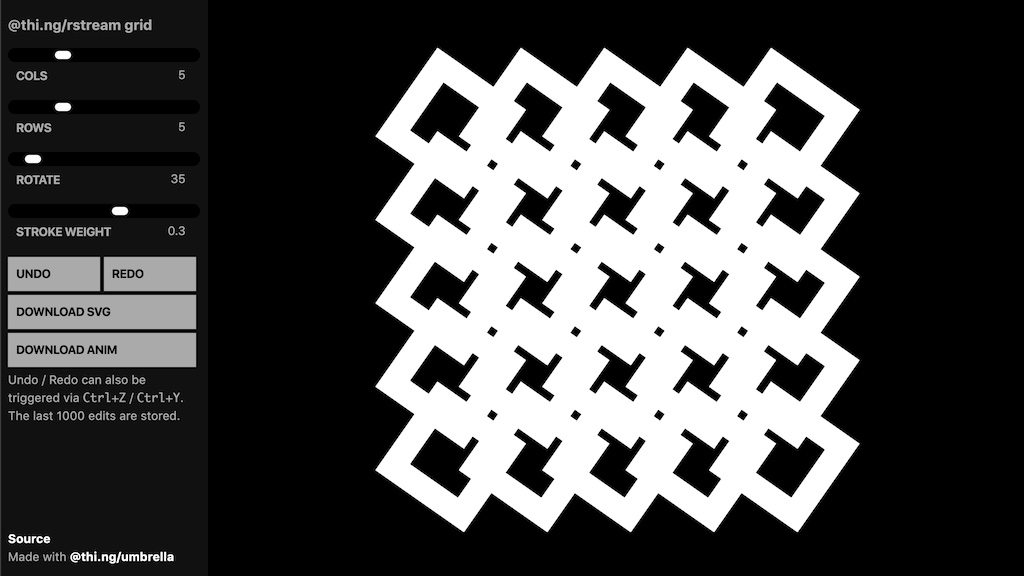This project is part of the @thi.ng/umbrella monorepo.
Declarative, reactive dataflow graph construction using @thi.ng/rstream, @thi.ng/atom and @thi.ng/transducers primitives.
Stream subscription types act as graph nodes and attached transducers as graph edges, transforming data for downstream consumers / nodes. Theoretically, allows cycles and is not restricted to DAG topologies, but care must be taken to avoid CPU hogging if those cycles are causing synchronous computation loops (it the user's responsibility to avoid these and keep any cycles async).
STABLE - used in production
yarn add @thi.ng/rstream-graph- @thi.ng/api
- @thi.ng/checks
- @thi.ng/errors
- @thi.ng/paths
- @thi.ng/resolve-map
- @thi.ng/rstream
- @thi.ng/transducers
Several demos in this repo's /examples directory are using this package.
A selection:
Interactive grid generator, SVG generation & export, undo/redo support
import { Atom } from "@thi.ng/atom";
import * as rs from "@thi.ng/rstream";
import * as rsg from "@thi.ng/rstream-graph";
// (optional) state atom to source value change streams from
const state = new Atom({a: 1, b: 2});
// graph declaration / definition
const graph = rsg.initGraph(state, {
// this node sources both of its inputs
// from values in the state atom
add: {
fn: rsg.add,
ins: {
a: { path: "a" },
b: { path: "b" }
},
},
// this node receives values from the `add` node
// and the given iterable
mul: {
fn: rsg.mul,
ins: {
a: { stream: "/add/node" },
b: { stream: () => rs.fromIterable([10, 20, 30]) }
},
}
});
// (optional) subscribe to individual nodes
graph.mul.subscribe({
next: (x) => console.log("result:", x)
});
// result: 30
// result: 60
// result: 90
// changes in subscribed atom values flow through the graph
setTimeout(() => state.resetIn("a", 10), 1000);
// result: 360A dataflow graph spec is a plain object where keys are node names and
their values are NodeSpecs, defining a node's inputs, outputs and the
operation to be applied to produce one or more result streams.
interface NodeSpec {
fn: NodeFactory<any>;
ins: IObjectOf<NodeInputSpec>;
outs?: IObjectOf<NodeOutputSpec>;
}Specification for a single "node" in the dataflow graph. Nodes here are
actually just wrappers of streams / subscriptions (or generally any form
of
@thi.ng/rstream
ISubscribable), usually with an associated transducer to transform /
combine the inputs and produce values for the node's result stream.
The fn function is responsible to produce such a stream transformer
construct and the library provides several general purpose helpers for
that purpose. The keys used to specify inputs in the ins object are
dictated by the actual node fn used. Most node functions with multiple
inputs will be implemented as
StreamSync
instances and the input IDs are used to locally rename input streams
within the StreamSync container. Alo see initGraph and
nodeFromSpec (in
/src/nodes.ts
for more details how these specs are compiled into stream constructs.
Specification for a single input, which can be given in different ways:
- Create a stream of value changes at given path in state
Atom
(passed to
initGraph):
{ path: "nested.src.path" }
{ path: ["nested", "src", "path"] }- Reference path to another node's output in the GraphSpec object. See @thi.ng/resolve-map for details.
{ stream: "/node-id/node" } // main node output
{ stream: "/node-id/outs/foo" } // specific output- Reference another node indirectly. The passed in
resolvefunction can be used to lookup other nodes, with the same logic as above. E.g. the following spec looks up the main output of node "abc" and adds a transformed subscription, which is then used as input for current node.
{ stream: (resolve) =>
resolve("/abc/node").subscribe(map(x => x * 10)) }- Provide an external input stream:
{ stream: () => fromIterable([1,2,3], 500) }- Single value input stream:
{ const: 1 }
{ const: () => 1 }If the optional xform key is given, a subscription with the given
transducer is added to the input and then used as input instead. This is
allows for further pre-processing of inputs.
Please see detailed documentation in the source code & test cases for further details.
Karsten Schmidt
© 2018 - 2019 Karsten Schmidt // Apache Software License 2.0
